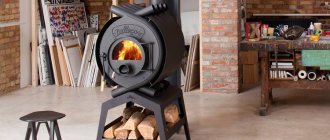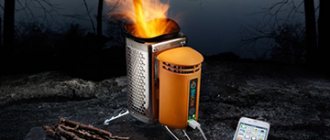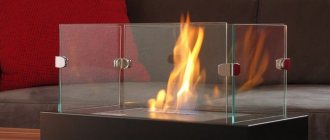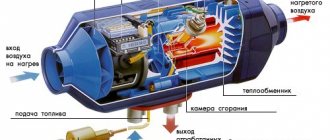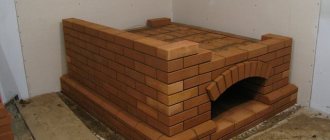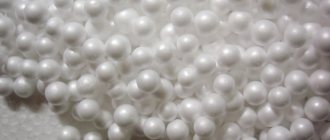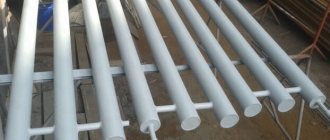This seemingly simple device will allow you to forget about the usual expensive heating
Have you noticed that the price of heating and hot water supply has increased and you don’t know what to do about it? The solution to the problem of expensive energy resources is a vortex heat generator. I will talk about how a vortex heat generator works and what is the principle of its operation. You will also find out whether it is possible to assemble such a device with your own hands and how to do it in a home workshop.
Photo of a vortex heat generator
Gas generators
The second type is gas generators. Such a device can be used in several directions, including generating electricity.
It is worth noting here that such a generator itself has nothing to do with electricity, since its main task is to produce flammable gas.
The essence of the operation of such a device is that during the oxidation of solid fuel (its combustion), gases are released, including flammable ones - hydrogen, methane, CO, which can be used for a variety of purposes.
For example, such generators were previously used in cars, where conventional internal combustion engines worked perfectly on the emitted gas.
Due to the constant jitter of the fuel, some motorists and motorcyclists have already begun installing these devices on their cars.
That is, to get a power plant, it is enough to have a gas generator, an internal combustion engine and a regular generator.
Vortex heating system and the operating principle of a vortex heat generator
A vortex heating heat generator is used to convert electricity into thermal energy and runs on water. The device was developed for space heating and can be used to generate mechanical and electrical energy. Externally, the heat generator looks like a cylinder equipped with a cyclone and a hydraulic braking device.
The operating principle of a vortex heat generator is as follows. Working fluid is supplied to the entrance of the vortex under pressure, then passes through it and stops in the braking device. As a result, the specified temperature regime is ensured without creating excess pressure in the pipes of the heating network.
Water, antifreeze or antifreeze can be used as a coolant. The choice depends on the climatic zone of use of the unit. In this case, the water does not need to be specially purified, since it is heated due to rotation, and not due to the influence of the heating element. Unlike other devices used to generate heat, a heat generator only uses electricity to pump water, which produces heat.
The installation of a vortex heating system works automatically depending on the air temperature outside the window of the heated house. Thermal energy is generated taking into account all the requirements for the environmental cleanliness of the process, and the heat generator itself is a fire and explosion-proof unit. Surprisingly, the device’s conversion rate of electricity into heat is even higher than 100%. Here, other physical properties are used, special pumps that convert electrical energy into hydraulic flows.
Heating of the coolant occurs due to eddy currents, which heat the surfaces of the device, and from them the heat is transferred to the coolant.
The heat generator can be controlled automatically, for example, to maintain the temperature of the coolant. The device is equipped with temperature sensors and a protection sensor against unacceptable overheating.
Today, vortex heating generators are used by only a few homeowners. Meanwhile, we can already say that the device can not only save resources such as oil or gas, but also have a positive effect on individual heating systems. Those who have already used the unit at home have noticed that the coolant swirled by the heat generator takes on a different structure. Thanks to this, the pipes stop rusting and salts no longer deposit on them. Consequently, the service life of the pipeline increases. Considering that in our country there is a critical situation with the deterioration of pipelines, vortex energy can become a real salvation.
Device Information
A heat generator is a special device whose main purpose is to generate heat by burning fuel loaded into it. In this case, heat is generated, which is spent on heating the coolant, which in turn directly performs the function of heating the living space.
The first heat generators appeared on the market back in 1856, thanks to the invention of the British physicist Robert Bunsen, who, during a series of experiments, noticed that the heat generated during combustion could be directed in any direction.
Since then, generators have, of course, been modified and are capable of heating a much larger area than they were 250 years ago.
Pump installation
Now you will need to select a water pump. Now in specialized stores you can purchase a unit of any modification and power.
What should you pay attention to?
- The pump must be centrifugal.
- Your engine will be able to spin it.
Install a pump on the frame; if you need to make more cross members, make them either from a corner or from strip iron of the same thickness as the corner. It is hardly possible to make a coupling without a lathe. Therefore, you will have to order it somewhere.
Diagram of a hydraulic vortex heat generator.
Potapov's vortex heat generator consists of a housing made in the form of a closed cylinder. At its ends there must be through holes and pipes for connection to the heating system. The secret of the design is inside the cylinder. There should be a nozzle behind the inlet hole. Its hole is selected individually for a given device, but it is desirable that it be half the size of a quarter of the diameter of the pipe body. If you do less, the pump will not be able to pass water through this hole and will begin to heat up. In addition, internal parts will begin to rapidly deteriorate due to the phenomenon of cavitation.
Tools: angle grinder or hacksaw, welding machine, electric drill, adjustable wrench.
Materials: thick metal pipe, electrodes, drills, 2 threaded pipes, couplings.
- Cut a piece of thick pipe with a diameter of 100 mm and a length of 500-600 mm. Make an external groove on it approximately 20-25 mm and half the thickness of the pipe. Cut the thread.
- Make two rings 50 mm long from the same pipe diameter. Cut an internal thread on one side of each half ring.
- Make covers from the same thickness of flat metal as the pipe and weld them on the unthreaded side of the rings.
- Make a central hole in the covers: one with the diameter of the nozzle, and the other with the diameter of the pipe. Make a chamfer on the inside of the cover, where the jet is located, with a larger diameter drill. The result should be a nozzle.
- Connect the heat generator to the system. Connect the pipe where the nozzle is located to the pump into the hole from which water is supplied under pressure. Connect the heating system input to the second pipe. Connect the outlet from the system to the pump inlet.
Water under the pressure created by the pump will pass through the nozzle of the vortex heat generator, which you make yourself. In the chamber it will begin to heat up due to intense stirring. Then feed it into the heating system. To regulate the temperature, install a ball locking device behind the nozzle. Cover it, and the vortex heat generator will circulate water inside the housing longer, which means the temperature in it will begin to rise. This is roughly how this heater works.
The main thing is the engine
You need to select a motor depending on what voltage is available. There are many schemes with which you can connect a 380 Volt motor to a 220 Volt network and vice versa. But that's another topic.
The assembly of the heat generator begins with an electric motor. It will need to be secured to the frame. The design of this device is a metal frame, which is most easily made from a square. Dimensions will need to be selected on site for those devices that will be available.
Drawing of a vortex heat generator.
List of tools and materials:
- angle grinder;
- welding machine;
- electric drill;
- set of drills;
- open-end or ring wrenches for 12 and 13;
- bolts, nuts, washers;
- metal corner;
- primer, paint, paint brush.
- Cut the squares using an angle grinder. Using a welding machine, assemble a rectangular structure. Alternatively, you can assemble it using bolts and nuts. This will not affect the final design. Select the length and width so that all parts fit optimally.
- Cut another piece of square. Attach it as a cross member in such a way that you can secure the engine.
- Paint the frame.
- Drill holes in the frame for the bolts and install the engine.
Installing the pump
Next we must choose the “right” water pump. The range of these tools today is so wide that you can find a model of any strength and size.
We only need to pay attention to two things:
- Will the engine be able to spin this pump;
- Is it (the pump) centrifugal?
Next, the pump is installed in the same frame; if necessary, additional fasteners are attached.
https://youtube.com/watch?v=ngegV5tl3fM
Frame
The body of a vortex generator is a cylinder, closed on both sides. There should be through holes on the sides through which the device will be connected to the heating system. But the main feature of the design is inside the body: a nozzle is located immediately near the inlet. The nozzle hole must be selected purely individually.
Note! It is desirable that the nozzle hole be half as large as 1/4 of the total diameter of the cylinder. If the hole is smaller, then water will not be able to pass through it in the required quantity and the pump will begin to heat up.
Moreover, internal elements will begin to be destroyed by cavitation.
To make the case we will need the following tools:
- Iron pipe with thick walls with a diameter of about 10 cm;
- Couplings for connection;
- Welding;
- Several electrodes;
- Impeller;
- A pair of pipes with threads;
- Electric drill;
- Drill;
- Adjustable wrench.
Now - directly to the manufacturing process.
- To begin with, we cut off a piece of pipe about 50-60 cm long and make an external groove on its surface about half the thickness, 2-2.5 cm. We cut the thread.
- We take two more pieces of the same pipe, each 5 cm long, and make a couple of rings from them.
- Then we take a metal sheet with the same thickness as the pipe, cut out original covers from it, and weld them where the thread was not made.
- We make two holes in the center of the covers - one of them around the circumference of the pipe, the second around the circumference of the nozzle. Inside the cover next to the jet we drill a chamfer so that we get a nozzle.
- We connect the generator to the heating system. We connect the pipe near the nozzle to the pump, but only to the hole from which water flows under pressure. We connect the second pipe to the entrance to the heating system, but the output must be connected to the pump inlet.
The pump will create pressure, which, acting on the water, will force it to pass through the nozzle of our design. In a special chamber, the water will overheat due to active mixing, after which it is supplied directly to the heating circuit. In order to be able to regulate the temperature, the vortex heat generator must be equipped with a special locking device located next to the pipe. If you slightly cover the constipation, the structure will take longer to move water through the chamber, therefore, the temperature will rise because of this. This is how this kind of heater works.
About other methods of alternative heating
Making TEGs with your own hands
To create a thermoelectric generator for your home, you need to use a Peltier element - a special component manufactured for this purpose and available commercially.
The basic structure of TEG is as follows:
- You need to take two vessels of similar shape (for example, two mugs), but one should be slightly smaller in size than the other so that it can fit in it.
- A Peltier element with wires coming out of it is placed at the bottom of the larger mug, and a second mug is covered on top of it.
- The wires coming from the Peltier element are connected to a voltage converter.
- Next, cold water is poured into the inner mug or snow is placed, after which this mini-installation begins to be heated.
It is advisable to use a Peltier element with as many thermoelements as possible. For example, a model that has 127 thermoelements is designed for a current of up to 12 amperes.
Potapov's own generator
There are many industrial generator models. For an experienced craftsman, it will not be difficult to make a vortex heat generator with your own hands:
The entire system must be securely fastened. Using corners, a frame is made. Welding or bolting can be used. The main thing is that the structure is durable. An electric motor is mounted on the frame. It is selected according to the area of the room, external conditions and available voltage. The water pump is mounted on the frame. When choosing it, take into account:
- a centrifugal pump is required;
- the engine has enough strength to spin it up;
- the pump must withstand liquid of any temperature.
The pump is connected to the engine. A cylinder 500-600 mm long is made from a thick pipe with a diameter of 100 mm. It is necessary to make two covers from thick flat metal:
- one must have a hole for the pipe;
- the second under the jet. A chamfer is made on the edge. It turns out to be a nozzle.
It is better to attach the covers to the cylinder with a threaded connection. The jet is located inside. Should its diameter be twice as small? parts of the cylinder diameter.
A very small hole will lead to overheating of the pump and rapid wear of parts.
The nozzle side pipe is connected to the pump supply. The second is connected to the top point of the heating system. The cooled water from the system is connected to the pump inlet. Water under pressure from the pump is supplied to the nozzle. In the heat generator chamber, its temperature increases due to vortex flows. Then it is supplied to the heating.
Cavitation generator circuit
Jet. Electric motor shaft. Vortex tube. Inlet nozzle. Outlet pipe. Vortex damper.
To regulate the temperature, a valve is placed behind the pipe. The less it is open, the longer the water is in the cavitator, and the higher its temperature.
When water passes through the nozzle, a strong pressure is obtained. He hits the opposite wall and spins due to this. By placing an additional obstacle in the middle of the flow, you can achieve greater returns.
Using the Converter
It should be noted that the electric generator of the described type has a relatively high power only until the water placed in the inner mug boils.
And after it boils, its power indicator and, accordingly, voltage drops. In order for this indicator to remain unchanged, a stabilizer should be installed.
This could be the KR1446PN1 microcircuit, which has a DIP package. This microcircuit is connected to a Peltier element, and for it itself you need to specify a five-volt mode, then the voltage will stably remain exactly that way.
Types of heat generators
All heat generators are divided into two main types:
- Rotary. A heat generator in which a vortex flow is created using a rotor.
- Static. In these types, a water vortex is created using special cavitation tubes. Water pressure is produced by a centrifugal pump.
Each type has its own advantages and disadvantages, which should be discussed in more detail.
Rotary heat generator
The stator in this device is the housing of a centrifugal pump.
Rotors can be different. There are many schemes and instructions for their implementation on the Internet. Heat generators are more of a scientific experiment, constantly under development.
Rotary generator design
The simplest design is considered to be with a disk. A number of holes are drilled across the entire surface of the rotor. Their depth and diameter are calculated in accordance with the rotor power.
The body is a hollow cylinder. The distance between the body and the rotating part is calculated individually (1.5-2 mm).
Heating of the medium occurs due to its friction with the housing and rotor. This is helped by bubbles that are formed due to cavitation of water in the rotor cells. The performance of such devices is 30% higher than static ones. The installations are quite noisy. They have increased wear of parts due to constant exposure to an aggressive environment. Constant monitoring is required: over the condition of oil seals, seals, etc. This significantly complicates and increases the cost of maintenance. They are rarely used to install heating at home; they have found a slightly different application - heating large industrial premises.
Industrial cavitator model
Static heat generator
The main advantage of these installations is that nothing rotates in them. Electricity is spent only on operating the pump. Cavitation occurs through natural physical processes in water.
The efficiency of such installations sometimes exceeds 100%. The medium for generators can be liquid, compressed gas, antifreeze, antifreeze.
The difference between the inlet and outlet temperatures can reach 100⁰С. When working with compressed gas, it is blown tangentially into the vortex chamber. He speeds up in it. When creating a vortex, hot air passes through a conical funnel, and cold air returns. Temperatures can reach 200⁰С.
Advantages:
- Can provide a large temperature difference between the hot and cold ends, operate at low pressure.
- Efficiency is not lower than 90%.
- Never overheats.
- Fire- and explosion-proof. Can be used in explosive environments.
- Provides fast and efficient heating of the entire system.
- Can be used for both heating and cooling.
Currently not used often enough. A cavitation heat generator is used to reduce the cost of heating a home or industrial premises in the presence of compressed air. The disadvantage remains the rather high cost of the equipment.
A little history
The vortex thermal generator is considered a promising and innovative development. Meanwhile, the technology is not new, since almost 100 years ago scientists were thinking about how to apply the phenomenon of cavitation.
Ranque tube, penetrating into which the gaseous medium is divided into hot and cold air - this phenomenon was discovered at the beginning of the twentieth century, and is used in practice today
The first operational pilot plant, the so-called “vortex tube”, was manufactured and patented by the French engineer Joseph Rank in 1934.
Rank was the first to notice that the temperature of the air at the inlet to the cyclone (air purifier) differs from the temperature of the same air stream at the outlet. However, at the initial stages of bench tests, the vortex tube was tested not for heating efficiency, but, on the contrary, for the cooling efficiency of the air stream.
The principle of operation of the vortex tube shown in the diagram is simple - the flow passes through the swirl chamber, where it is divided into two streams with different temperatures
The technology received new development in the 60s of the twentieth century, when Soviet scientists figured out how to improve the Ranque tube by running liquid into it instead of an air jet.
Due to the higher density of the liquid medium, compared to air, the temperature of the liquid, when passing through the vortex tube, changed more intensively. As a result, it was experimentally established that the liquid medium, passing through the improved Ranque tube, heated up abnormally quickly with an energy conversion coefficient of 100%!
Unfortunately, there was no need for cheap sources of thermal energy at that time, and the technology did not find practical application. The first operating cavitation installations designed to heat a liquid medium appeared only in the mid-90s of the twentieth century.
The photo shows a demonstration vortex generator in which water circulates in a closed loop
A series of energy crises and, as a consequence, increasing interest in alternative energy sources served as the reason for resuming work on effective converters of the energy of water jet movement into heat. As a result, today you can buy a unit with the required power and use it in most heating systems.
Scope of application
| Illustration | Description of application |
| Heating. Equipment that converts the mechanical energy of water movement into heat is successfully used in heating various buildings, from small private buildings to large industrial facilities. By the way, in Russia today you can already count at least ten settlements where centralized heating is provided not by traditional boiler houses, but by gravity generators. | |
| Heating of running water for domestic use. The heat generator, when connected to the network, heats the water very quickly. Therefore, such equipment can be used to heat water in an autonomous water supply system, in swimming pools, bathhouses, laundries, etc. | |
| Mixing immiscible liquids. In laboratory conditions, cavitation units can be used for high-quality mixing of liquid media with different densities until a homogeneous consistency is obtained. |
Integration into the heating system of a private home
In order to use a heat generator in a heating system, it must be installed into it. How to do this correctly? In fact, there is nothing complicated about it.
Scheme for introducing a vortex heat generator into the heating system of a country house or apartment - apart from the presence of a pump, there are no special differences from installing a conventional boiler
In front of the generator (marked 2 in the figure) a centrifugal pump (1 in the figure) is installed, which will supply water with a pressure of up to 6 atmospheres. After the generator, an expansion tank (6 in the figure) and shut-off valves are installed.
Advantages of using cavitation heat generators
Advantages of a vortex source of alternative energy
Economical. Thanks to the efficient consumption of electricity and high efficiency, the heat generator is more economical compared to other types of heating equipment.
Small dimensions compared to conventional heating equipment of similar power. A stationary generator, suitable for heating a small house, is twice as compact as a modern gas boiler.
If you install a heat generator in a regular boiler room instead of a solid fuel boiler, there will be a lot of free space left.
Low installation weight. Due to its light weight, even large high-power installations can be easily placed on the floor of the boiler room without building a special foundation. There are no problems at all with the location of compact modifications.
The only thing you need to pay attention to when installing the device in a heating system is the high noise level. Therefore, installation of the generator is possible only in non-residential premises - in a boiler room, basement, etc. The device has a small number of mechanically moving elements, and there is no complex electronics at all
Therefore, the likelihood of device failure, in comparison with gas or even solid fuel boilers, is minimal
Simple design. The cavitation type heat generator is so simple that there is nothing to break in it.
The device has a small number of mechanically moving elements, and there are no complex electronics at all. Therefore, the likelihood of device failure, in comparison with gas or even solid fuel boilers, is minimal.
There is no need for additional modifications. The heat generator can be integrated into an existing heating system. That is, there is no need to change the diameter of the pipes or their location.
There is no need for water treatment. If a running water filter is needed for normal operation of a gas boiler, then by installing a cavitation heater, you don’t have to worry about blockages.
Due to specific processes in the working chamber of the generator, blockages and scale do not appear on the walls.
The operation of the equipment does not require constant monitoring. If solid fuel boilers need to be looked after, the cavitation heater operates in autonomous mode.
The operating instructions for the device are simple - just plug in the engine and, if necessary, turn it off.
Environmental friendliness. Cavitation installations do not affect the ecosystem in any way, because the only energy-consuming component is the electric motor.
Peculiarities
A wood-fired power plant is not a new invention, but modern technologies have made it possible to somewhat improve previously developed devices. Moreover, several different technologies are used to generate electricity.
In addition, the concept of “wood-burning” is somewhat inaccurate, since any solid fuel (wood, wood chips, pallets, coal, coke), in general, anything that can burn, is suitable for the operation of such a station.
Let us immediately note that firewood, or rather the process of its combustion, acts only as an energy source that ensures the functioning of the device in which electricity is generated.
The main advantages of such power plants are:
- The ability to use a wide variety of solid fuels and their availability;
- Receive electricity anywhere;
- The use of different technologies makes it possible to obtain electricity with a variety of parameters (sufficient only for regular phone recharging and up to powering industrial equipment);
- It can also act as an alternative if power outages are common, as well as the main source of electricity.
Vortex damper
The work of the vortex damper is based on this:
- Two rings are made, width 4-5 cm, diameter slightly smaller than the cylinder.
- 6 plates ¼ length of the generator body are cut out of thick metal. The width depends on the diameter and is selected individually.
- The plates are fixed inside the rings opposite each other.
- The damper is inserted opposite the nozzle.
Development of generators continues. To increase performance, you can experiment with the damper.
As a result of work, heat loss occurs into the atmosphere. To eliminate them, you can make thermal insulation. First it is made of metal, and then sheathed on top with any insulating material. The main thing is that it can withstand boiling temperature.
To facilitate commissioning and maintenance of the Potapov generator, you must:
- paint all metal surfaces;
- make all parts from thick metal, so the heat generator will last longer;
- During assembly, it makes sense to make several covers with different hole diameters. The optimal option for a given system is selected experimentally;
- Before connecting consumers, having looped the generator, it is necessary to check its tightness and performance.
Thermoelectric generators
Power plants with generators built according to the Peltier principle are quite an interesting option.
Physicist Peltier discovered an effect that boils down to the fact that when electricity is passed through conductors consisting of two dissimilar materials, heat is absorbed at one of the contacts, and heat is released at the other.
Moreover, this effect is the opposite - if the conductor is heated on one side and cooled on the other, then electricity will be generated in it.
It is the opposite effect that is used in wood-fired power plants. When burned, they heat up one half of the plate (it is a thermoelectric generator), consisting of cubes made of different metals, and the second part is cooled (for which heat exchangers are used), as a result of which electricity appears at the terminals of the plate.
But such a generator has several nuances. One of them is that the parameters of the released energy directly depend on the temperature difference at the ends of the plate, therefore, to equalize and stabilize them, it is necessary to use a voltage regulator.
The second nuance is that the energy released is just a side effect; most of the energy when burning wood is simply converted into heat. Because of this, the efficiency of this type of station is not very high.
The advantages of power plants with thermoelectric generators include:
- Long service life (no moving parts);
- At the same time, not only energy is generated, but also heat, which can be used for heating or cooking;
- Quiet operation.
Wood-burning power plants using the Peltier principle are a fairly common option, and they produce both portable devices that can only release electricity to charge low-power consumers (phones, flashlights), and industrial ones that can power powerful units.
Kinds
The main task of a cavitation heat generator is the formation of gas inclusions, and the quality of heating will depend on their quantity and intensity. In modern industry, there are several types of such heat generators, differing in the principle of producing bubbles in the liquid. The most common are three types:
- Rotary heat generators - the working element rotates due to an electric drive and produces fluid turbulence;
- Tubular - change pressure due to a system of pipes through which water moves;
- Ultrasonic - the heterogeneity of the liquid in such heat generators is created due to low-frequency sound vibrations.
In addition to the above types, there is laser cavitation, but this method has not yet found industrial implementation. Now let's look at each type in more detail.
Rotary heat generator
It consists of an electric motor, the shaft of which is connected to a rotor mechanism designed to create turbulence in the liquid. A special feature of the rotor design is the sealed stator, in which heating occurs. The stator itself has a cylindrical cavity inside - a vortex chamber in which the rotor rotates. The rotor of a cavitation heat generator is a cylinder with a set of depressions on the surface; when the cylinder rotates inside the stator, these depressions create heterogeneity in the water and cause cavitation processes to occur.
Rice. 3: Rotary type generator design
The number of recesses and their geometric parameters are determined depending on the model of the vortex heat generator. For optimal heating parameters, the distance between the rotor and stator is about 1.5 mm. This design is not the only one of its kind; over the long history of modernizations and improvements, the rotor-type working element has undergone a lot of transformations.
One of the first effective models of cavitation converters was the Griggs generator, which used a disk rotor with blind holes on the surface. One of the modern analogues of disk cavitation heat generators is shown in Figure 4 below:
Rice. 4: disk heat generator
Despite the simplicity of the design, rotary-type units are quite complex to use, as they require precise calibration, reliable seals and adherence to geometric parameters during operation, which makes their operation difficult. Such cavitation heat generators are characterized by a fairly low service life - 2 - 4 years due to cavitation erosion of the housing and parts. In addition, they create a fairly large noise load during operation of the rotating element. The advantages of this model include high productivity - 25% higher than that of classic heaters.
Tubular
A static heat generator has no rotating elements. The heating process in them occurs due to the movement of water through pipes that taper in length or due to the installation of Laval nozzles. Water is supplied to the working element by a hydrodynamic pump, which creates a mechanical force of the fluid in a narrowing space, and when it passes into a wider cavity, cavitation vortices occur.
Unlike the previous model, tubular heating equipment does not make much noise and does not wear out as quickly. During installation and operation, you do not need to worry about precise balancing, and if the heating elements are destroyed, their replacement and repair will cost much less than rotary models. The disadvantages of tubular heat generators include significantly lower productivity and bulky dimensions.
Ultrasonic
This type of device has a resonator chamber tuned to a certain frequency of sound vibrations. A quartz plate is installed at its input, which produces oscillations when electrical signals are supplied. The vibration of the plate creates a wave effect inside the liquid, which reaches the walls of the resonator chamber and is reflected. During the return movement, the waves encounter direct vibrations and create hydrodynamic cavitation.
Rice. 5: Operating principle of ultrasonic heat generator
Next, the bubbles are carried away by the water flow through the narrow inlet pipes of the thermal installation. When moving into a wide area, the bubbles collapse, releasing thermal energy. Ultrasonic cavitation generators also have good performance characteristics, since they do not have rotating elements.
Operating principle
This is what a working Potapov generator looks like - the flow of water from the pipe is very hot
Traditionally, it was believed that cavitation is a parasitic phenomenon characterized by the intense formation of bubbles, which, during collapse, provoke the destruction of surrounding objects.
A typical example of the consequences of cavitation is the destruction of ship propellers or the destruction of the impeller of vane pumps. A vortex type heat generator is a device in which the parasitic phenomenon is beneficial.
The photo shows another Potapov heat generator, connected to a heating radiator during testing
Cavitation makes it possible not to give heat to water, but to extract heat from moving water, while heating it to significant temperatures.
Despite the fact that cavitation is a parasitic phenomenon, the structural elements of modern heat generators, unlike the same ship propellers, do not suffer. This is explained by the fact that cavitation processes do not occur around the disk activator, but behind it.
Operating principle of the cavitation converter
| Illustration | Process description |
|
Design and operating features
This is what a stationary cavitation unit looks like connected to an industrial heating system
The design of operating samples of vortex heat generators is externally simple. We can see a massive motor, to which is connected a cylindrical snail device.
"Snail" is a modified version of Ranque's trumpet. Due to its characteristic shape, the intensity of cavitation processes in the cavity of the “snail” is much higher in comparison with a vortex tube.
A disk activator mounted on a shaft - this device is responsible for the movement of the aquatic environment and for creating the cavitation effect
In the cavity of the “snail” there is a disk activator - a disk with special perforation. When the disk rotates, the liquid medium in the “snail” is activated, due to which cavitation processes occur:
- The electric motor turns the disk activator . The disk activator is the most important element in the design of the heat generator, and it is connected to the electric motor by means of a straight shaft or a belt drive. When the device is turned on in operating mode, the engine transmits torque to the activator;
- The activator spins the liquid medium . The activator is designed in such a way that the liquid medium, entering the cavity of the disk, swirls and acquires kinetic energy;
- Conversion of mechanical energy into thermal energy . Leaving the activator, the liquid medium loses acceleration and, as a result of sudden braking, a cavitation effect occurs. As a result, kinetic energy heats the liquid medium to + 95 ° C, and mechanical energy becomes thermal.
Recommendations for selection
Features of the models
The vortex cavitation heat generator exists in different designs. Today, the most common devices are water-based, that is, liquid acts as a coolant.
But it is also possible to purchase a solid fuel unit, the output of which produces a gaseous mixture of flue gas and air.
The high-performance vortex solid fuel heat generator is distinguished by the ability to burn wood with high humidity (up to 65%). Accordingly, when choosing, the purpose of the unit and the expected load are taken into account, since there are versions with different levels of thermal power. Depending on the size of the object to be served, a suitable device is selected.
In the case of solid fuel equipment, it is important to take into account the rate of fuel consumption, the size of the loading chamber and the type of fuel loading
You can select a vortex heat generator of different types according to the level of thermal power, or you can pay attention to the clause in the accompanying documentation about how much volume is allowed to be heated. The weight and overall dimensions of the equipment are also important.
Review of models of different designs
Watch a video about the product:
If you choose a solid fuel version, then in this case we consider more efficient equipment with a thermal power of 250 to 700 kW. For example, models TVV-R-250, TVV-R-500, TVV-R-700. All of them involve manual loading of fuel. But more powerful versions consume more fuel. If the 250 model consumes 120 kg/hour, then the 700 version consumes about 340 kg/hour. There are much more efficient devices with a thermal power of 2,500 kW. If you plan to use such vortex heat generators, then their price will be noticeably higher.
Recommendations for use
The smaller the overall dimensions of such equipment, the simpler its operation will be. For example, there are completely autonomous devices with automatic control. In this case, the user does not need to participate in the process. But when using some versions of solid fuel heat generators, it is impossible to do without the participation of a trained operator to load fuel, since the unit data assumes manual supply of wood.
Today, there are different versions of such equipment with fully automated execution, including preset temperature conditions. Considering that units of this kind are completely safe, both from the point of view of environmental friendliness and from the point of view of fire safety, there is no need for their constant monitoring.
Thus, to organize a heating system and hot water supply, it is not always necessary to resort to standard solutions. In practice, it turns out that when using thermal installations based on vortex heat generators, significant savings are noted in comparison with other types of heating systems.
As a result, you can get not only high-performance equipment, but also save money during its operation. Despite the rather high cost of such units, their further operation fully pays off, and you won’t have to wait too long for this, since in some cases the payback period reaches 6 months.
Factory models
If the choice falls on a ready-made unit, then it is better to give preference to the products of the following leading manufacturers that have guarantees and good reviews about heat generators:
- Graviton – 500,000 rubles;
- Yusmar – from 650,000 rubles;
- Euroalliance – from 75,000 rubles.
Remember that the efficiency of a heat generator depends not only on the quality of the unit, but also on the place where it is used.
The closer to the poles of the planet, the less effective the device is, since interaction with the Sun is minimal.
The video shows a new type of vortex heat generator
Does it work or not?
However, a key question arises here
and the main mystery of GVTG. Namely, the effect of additional heat generation, which some manufacturers claim. In two paragraphs, the essence of the problem is this.
If we explain the heating of water in a generator
by direct conversion of work into heat - due, for example, to internal friction in a liquid, or the collapse of gas bubbles on braking devices, or dissipation of the energy of acoustic vibrations - then the law of conservation of energy is not violated. And the energy conversion coefficient will be less than unity.
But if there really is additional heat generation
, and the conversion coefficient is more than 100%, then some arsenal of alternative science will have to be involved in explaining the anomalous phenomenon: the theory of the world ether, a specific interpretation of the virial theorem, torsion fields, recrystallization of liquid water, cold thermonuclear fusion and, finally, the influence of the cosmological vector potential.
Therefore, we decided to test it in practice
How does a hydraulic vortex heat generator work, developed and manufactured under patent (No. 2301947 dated June 27, 2007) by Constanta Group LLC. Two goals were set. First: to understand whether it is possible to build an effective heat supply system for a country house based on the GVTG. Second: using available means to check whether the law of conservation of energy holds.
For testing
Konstanta Group LLC provided its GVTG with a 4 kW electric pump, suitable for heating a country house with an area of 100 m2. The generator operated in a closed cycle and in 27 minutes heated 18 liters of water from 11 to 80°C.
Based on the data received
We made a graph of temperature changes over time. One glance at it is enough to understand that there is no additional heat generation. While the water was relatively cold, the temperature increased linearly. When reaching 60°C, the heat capacity of water began to change simultaneously and the pressure in the system began to increase. The heating rate began to fall. Everything is according to the classic scenario.
Based on measurement results
We made calculations of energy conversion efficiency. And they also obtained results that were quite consistent with the traditional scientific paradigm, but very impressive. Namely: in 0.45 hours, a 4-kilowatt pump should have consumed 1.8 kWh of electrical energy. At the same time, the thermal energy of the system, according to calculations, amounted to 1.44 kWh.
Thus, it was achieved in practice
direct conversion ratio is greater than 80%. But in reality it is higher. And if we take into account that the voltage in the network is slightly lower than 220 V, and the heat was dissipated and was used to heat not only the water, but also the metal itself, then it is apparently possible to achieve the figure of 90%.
Classic version
As noted, a wood-fired power plant uses several technologies to produce electricity. The classic one among them is steam power, or simply the steam engine.
Everything is simple here - wood or any other fuel, when burned, heats up the water, as a result of which it turns into a gaseous state - steam.
The resulting steam is supplied to the turbine of the generating set, and due to rotation, the generator generates electricity.
Since the steam engine and generator set are connected in a single closed circuit, after passing through the turbine the steam is cooled, fed back into the boiler, and the whole process is repeated.
This power plant scheme is one of the simplest, but it has a number of significant disadvantages, one of which is the danger of explosion.
After water passes into a gaseous state, the pressure in the circuit increases significantly, and if it is not regulated, there is a high probability of rupture of the pipelines.
And although modern systems use a whole set of valves that regulate pressure, the operation of a steam engine still requires constant monitoring.
In addition, ordinary water used in this engine can cause scale to form on the walls of the pipes, which reduces the efficiency of the station (scale impairs heat transfer and reduces the throughput of the pipes).
But now this problem is solved by using distilled water, liquids, purified impurities that precipitate, or special gases.
But on the other hand, this power plant can perform another function - to heat the room.
Everything is simple here - after performing its function (rotation of the turbine), the steam must be cooled so that it turns into a liquid state again, which requires a cooling system or, simply, a radiator.
And if you place this radiator indoors, then in the end we will receive not only electricity from such a station, but also heat.
Pros and cons of a wood-fired power plant
A wood-fired power plant is:
- Fuel availability;
- Possibility to get electricity anywhere;
- The parameters of the generated electricity are very different;
- You can make the device yourself.
- Among the shortcomings it is noted:
- Not always high efficiency;
- Cumbersome design;
- In some cases, generating electricity is just a side effect;
- To generate electricity for industrial use, large amounts of fuel must be burned.
In general, the production and use of solid fuel power plants is an option worthy of attention, and it can not only become an alternative to power grids, but also help in places remote from civilization.
Security measures
Compliance with important rules and recommendations will help you avoid mistakes associated with the operation of inductor devices.
- Open sections of current conductors must be insulated.
- Induction heating devices are placed at a distance of 80 cm from the ceiling or floor, 30 cm from walls and furniture.
- Safe operation of the device will be ensured by installing a pressure gauge, an automatic control panel and air release.
And most importantly! Whether it’s an induction furnace made from a welding inverter or an electromagnetic boiler, responsibility for possible consequences rests with the manufacturer of the homemade device.
Anyone can assemble vortex induction heaters if they take into account all the nuances!
The idea of creation
What to do if you don’t have enough money to purchase a heat generator? How to make it yourself? I will tell you about my own experience in this matter.
We got the idea to make our own heat generator after getting acquainted with various types of heat generators. Their designs seemed quite simple, but not fully thought out.
There are two known designs of such devices: rotary and static. In the first case, as you can guess from the name, a rotor is used to create cavitation; in the second, the main element of the device is the nozzle. To make a choice in favor of one of the design options, let’s compare both designs.
Tips you should listen to
Diagram of a heat gun.
- Be sure to protect the Potapov vortex heat generator by painting all surfaces.
- During operation, its internal parts will be in a very aggressive environment caused by cavitation processes. Therefore, try to make both the body and everything that is in it from thick material. Don't skimp on hardware.
- Make several versions of lids with different inlet holes. Then it will be easier to select their diameter in order to obtain high performance.
- The same applies to the vibration damper. It can also be modified.
Build a small laboratory stand where you will test all the characteristics. To do this, do not connect consumers, but loop the pipeline to the generator. This will simplify its testing and selection of the necessary parameters. Since complex instruments for determining the efficiency factor at home can hardly be found, the following test is proposed.
Turn on the vortex heat generator and note the time when it heats the water to a certain temperature. It is better to have an electronic thermometer, it is more accurate. Then make changes to the design and run the experiment again, monitoring the temperature increase. The more the water heats up at the same time, the more preference will need to be given to the final version of the installed improvement in the design.

